#poc problems
Text
Idk if it’s the constant background buzz of the trauma of being a poc in a racist society coming to the forefront, or the fact that a lot of racism I’ve personally faced was from white queer folks But. I have been seeing a lot of “I was from a conservative family/was conservative until I found out I was queer” stories again, and to those people, I Have Some Words That I Hope You All Will Listen To
So congratulations on getting away from your conservative family/your self discovery of queerness! Genuinely good job, it isn’t easy. You’ve probably had to unlearn all the homophobia/transphobia/queerphobia that you were taught growing up. Your journey of unlearning bigotry has just begun.
Conservatives are really fucking bigoted, not just in the queerphobia but also the racism. You have unlearned the first part, but that second part is still there. There is a still a lot of internalized racial bias that queer people who grew up Conservative have, and a lot of those people make the mistake of thinking just because you are now one marginalized identity, you are now incapable of any kind of bigotry for the rest of your life. Being queer =/= being a poc. We are all marginalized but we’ve got a different set of problems and the ways people oppress us.
So don’t make that mistake. Keep unlearning. You’ve already started doing it, you can keep on doing it. You will be a much more educated person from it, and not end up being an ass to a lot of poc
#usually I would not ask people to reblog but this one means a lot to me since it effects my daily life a lot as a poc#so i'd really appreciate it if people could#obligatory op is a queer person of color tag in case people want to discredit me#queer problems#poc problems#queer poc
32 notes
·
View notes
Text
Yall mfs better not call Tenoch Huerta his characters name instead of his real name for the next 3-5 years like you did with Steven Yeun and Manny Jacinto
81 notes
·
View notes
Text
Something something
being a poc in queer spaces is always interesting. I sometimes have people complimenting my ‘androgynous’ or ‘masc’ facial features or that it gives them gender envy.
My larger nose, big dark brows, prominent cheekbones and overcast browbone. These features in particular seem to get the most attention.
Not to mention the fact that I’m already perceived more masculine bc I have obvious, visibly thick hair on my limbs and face.
(…ethnic features?…)
But when I come back to poc spaces/friendgroups those features aren’t seen as inherently androgynous/masculine. Just normal.
I’m not exactly offended, I’m aware that the way I act and present myself also leads people to assume things.
But…idk. Feels off.
Thoughts?
#rant over#gender somethingism that deals with masculinization of certain features#i’ll probably delete this later#poc problems#desi things#idk#discourse??#bipoc#woc#queer#lgbtq
2 notes
·
View notes
Text
oh i KNOW a cop ain’t drove by me slowly cause he thought i was holding something OTHER than my very black iPhone and jacket
14 notes
·
View notes
Text
Me (African-Australian) when I found out African Americans also had to go through everyone trying to touch your hair in high school:

There were about 5 people with hair like mine in the school (including me, my brother and sister).
I didn't go around trying to touch anyone else's hair, but they always wanted touch mine. Especially when I started wearing it in an afro. The times without my permission made me feel so uncomfortable.
Not until I watched Black White with Jarvis Johnson that I found out that it was really common.
Reblog if it happened to you too ;-;
#poc#blacklivesmatter#poc problems#like#what was that about#i remember being so uncomfortable#afro problems#afro#natural hair#person of color#african american#african australian
5 notes
·
View notes
Text
And can I just say that it's beyond cowardly to use "It's my culture" as an excuse for shitty behaviour? First off, cultures evolve. Just like people do. Second off, everyone in the community isn't homophobic OR misogynistic even if it suits someone's agenda to pretend they are. If someone wants to espouse terrible values, that's on them. They have no business throwing everyone else under the bus with them.
#personal#rant tw#kuwait#india#poc problems#and this attitude isn't reserved to just Muslims btw no matter how much certain 'progressive' Islamophobes like to pretend that is the case#one only has to look at the reaction that one MP BJP politician had to that Dabur ad#and propped up and echoed by many BJP supporters#the truth is#far righters have more in common than not#across communities/borders#even if they support leftists/liberals if they move abroad because suddenly THEY are on the receiving end of similar oppression#basically#some people are raving hypocrites#indian politics#world politics
16 notes
·
View notes
Text
POC problems[a rant]:
I hate it when i get a new lipstick or make-up item that is a shade i really like and make me feel pretty but it doesnt show up on my dark lips or it blotches and doesnt look good, but as soon as i hand it to my white cousin it looks great on her pink lips and light skin tone. I want to look and feel good too but im stuck with clear and usually dark tones colors. There is occasions when i find the lucky beautiful color and it shows up but why did i have to pay 16.99 or more for it when i litteraly saw the same thing for half the price but i just doesnt show :[[[ this is ofc not all make-up but it happens pretty often for me, atleast 4 outta my 8 lipsticks and glosses i cant use cuz they dont show or dont look good on my dark complexion and lips :[[
Sorry for the rant but im kinda sad ab this
6 notes
·
View notes
Text
Now that Ghibli's new movie is coming out soon, I've been thinking about anime films and wanna talk about my favorite animated movie ever, Tokyo Godfathers.
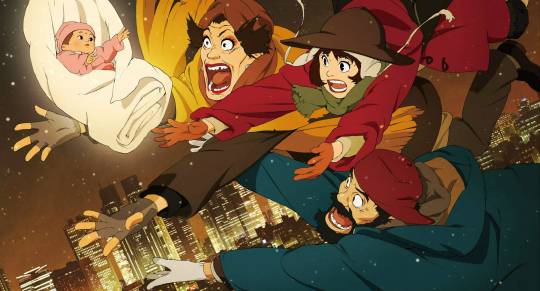
TG is a 2003 tragicomedy by Satoshi Kon, following three unhoused people––an alcoholic, a runaway girl, an a trans woman––who find a baby in a dumpster and set off across Tokyo to reunite her with her parents.
If you like the sound of that, go watch it because the rest of this post is spoilers and I have FEELINGS about this movie.
URGHH, the fact that only two moments of true kindness, generosity, and care given to the three protagonists without any expectation of reciprocity are given by a Latin-American immigrant couple and a drag show club full of trans women. The fact that, despite her loud and dramatic personality, Hana is the glue that holds the team together and the heart of the whole movie. The fact that this movie pulls no punches at showing the violence and inhumanity committed by "civilized Japanese society" against the unhoused. The fact that Miyuki craves to be loved by her parents and ends up seeing Hana as her true mother. The fact that Miyuki starts off accidentally using transphobic language against Hana, but slowly begins calling her "Miss Hana" out of respect. The fact that, according to Kon, Hana's role in the story is as a mythological trickster god and "disturb the morality and order of society, but also play a role in revitalizing culture." The fact that Hana so desperately wants to be part of a true family, yet is willing to sacrifice her found family so they can be with their own, and is rewarded for her good deeds in the end by becoming a godmother. The fact that, throughout the movie, wind and light have been used to signify the presence of god's hand/influence (this movie's about nondenominational faith––faith in yourself, faith in others, faith in a higher power. Lots of religious are referenced, such as Buddhism/Hinduism, Christianity, and Shintoism), and in the climax of the film, as Hana jumps off a building to save a baby that isn't hers, a gust of wind and a shower of light save her from death. The fact that god saves a trans woman's life because she proved herself a mother, and that shit makes me CRY.
#ramblings#long post#not art#personal#it's the ultimate found family movie#not without its problems. i really dont like its depiction of mental health#for a movie that does an otherwise great job spotlighting the unhoused crisis in japan and its society's oppressive distain towards women#and queer people. it really drops the ball on depicting one of the biggest contributors to the crisis#but otherwise this movie is so fucking full of love and kindness and second chances and how fucking good queer folks and poc are#it blows my mind that this film came out in 2003 and the main protagonist is a trans woman who's just the fucking best#the recent gkids dub is REALLY good by the way! they got shakina nayfack; a trans va; to voice Hana!#the dub made great strides to undo a lot of the original misgendering and mistranslations#also its a christmas movie#also the ost was done by the band that did earthbound's ost
2K notes
·
View notes
Text
Fear: Using Stoicism to Shape Characters

WC: 2,730
Introduction
Like many people, I suffer from severe panic and anxiety attacks. My heart races at what feels like a thousand beats per minute, I get a cold sweat, and my thoughts do not have a filter. The latter of which, I find the most dangerous and disturbing, especially when said attacks get triggered by something so small or nothing at all.
A lot of the time, they boil down to not feeling safe. I feel like I’m vulnerable, that the worst things that happened to me will happen again tenfold, or I’ve become the worst person in existence. Fear, as a lot of us know, can have us assume the worst.
I’m still working on managing my fear, if it can be managed at all, but a lot of what I’ve been practicing is essentially Stoicism. Epictetus, a Greek Stoic philosopher, often highlighted that it is not events themselves that disturb people, but rather their judgments about those events. One famous quote attributed to Epictetus that reflects this idea is: “People are not disturbed by things, but by the view they take of them.”
This sentiment suggests that fear and other negative emotions stem not from objective reality but from our interpretations and perceptions of reality.
I thought, “What a wonderful way to get to know our characters!” Not only do we have to have a grasp on the world around them, we have to understand the extent of how they perceive said reality and how it leads to their own fears as well as their ambitions, passions, hate, love, etc.
Amor Fati
One of my favorite phrases is “amor fati.” It’s what helped me most in navigating my own fears and, as a result, writing some ways in which my characters handle theirs.
The idea of “amor fati” is closely associated with philosophers like Epictetus and Marcus Aurelius, even though they didn't use those exact words. However, it was Nietzsche who made it a key part of his philosophy. He believed that true greatness comes from embracing fate and wanting nothing to change, not in the past, present, or future. In simple terms, it means loving and accepting everything that happens, rather than just enduring it.
When considering the relationship between “amor fati” and fear, several key points emerge:
Acceptance of the Uncontrollable: Fear often arises from the unknown or from circumstances beyond our control. “Amor fati” encourages individuals to relinquish their resistance to such uncertainties and to accept that life is inherently unpredictable. By embracing fate, individuals can find solace in the realization that some things are simply beyond their power to change or influence.
Facing Adversity with Resilience: Rather than viewing challenges as threats to be avoided or overcome, individuals can approach them with a sense of equanimity and resilience. Instead of succumbing to fear or anxiety in the face of challenges, one can choose to see them as opportunities for growth and self-discovery. By embracing adversity as an integral part of life’s journey, individuals can cultivate the strength and fortitude necessary to navigate difficult times with grace and composure.
Gratitude for All Experiences: Fear often stems from a sense of insecurity or dissatisfaction with one’s circumstances. “Amor fati” cultivates gratitude for all experiences, both positive and negative, recognizing that each contributes to the richness and depth of life. By embracing fate with gratitude and appreciation, individuals can mitigate the fear of the unknown and find peace and contentment in the present moment.
This idea is what helps form a “baseline” for my way of thinking and perceiving fear, which is what many people, fictional characters included, tend to mix up.
You don’t need to adopt the same mantra, of course, but I believe that having this Ground 0 in your own personal philosophy will add further depth and characterization in writing. It provides a deeper perspective on why your characters think the same or why they may deviate.
Distinction Between Events and Perceptions
Let’s go back to what Epictetus said: “People are not disturbed by things, but by the view they take of them.” Stoicism teaches that events themselves are neutral; it is our interpretation of those events that shapes our emotional responses. This concept is often referred to as “cognitive appraisal” or “judgment” in Stoic philosophy.
In practical terms, this means that two individuals may encounter the same external circumstance, yet react to it in vastly different ways based on their subjective interpretations. For example, consider a person who loses their job unexpectedly. While one individual may perceive this event as a devastating blow to their self-worth and security, another may view it as an opportunity for growth and new possibilities. The event itself—the loss of a job—remains the same, but the emotional response varies depending on the individual's perception of the situation.
Epictetus’s insight invites us to reflect on the role of our perceptions in shaping our emotional experiences. It suggests that our judgments, beliefs, and attitudes about the events we encounter play a crucial role in determining how we feel and behave in response to those events. By recognizing this distinction between events and perceptions, individuals can gain greater agency over their emotional lives.
Moreover, understanding this distinction empowers individuals to practice what Epictetus called the “dichotomy of control”—the Stoic principle of focusing only on what is within our power to control, namely our thoughts, attitudes, and responses, rather than becoming consumed by external circumstances beyond our control. By directing our attention inward and cultivating a mindset of resilience and rationality, we can navigate life's challenges with greater equanimity and inner peace.
Applying this to character development, particularly in relation to crafting a character’s fears, can add depth and complexity to the character.
Understanding the Character’s Perception of Fearful Events:
Explore how the character interprets and perceives the events or situations that evoke fear. What underlying beliefs, past experiences, or personal values shape their perception of these events?
Consider whether the character’s fear is rooted in the objective reality of the situation or in their subjective interpretation of it. For example, is their fear based on genuine physical danger, or is it driven by irrational beliefs or past traumas?
Revealing Character Traits and Beliefs:
A character’s response to fear can provide insight into their personality, values, and beliefs. For instance, do they confront their fears head-on with courage and resilience, or do they succumb to anxiety and avoidance?
Consider how the character’s fear reflects broader themes or conflicts in the story. For example, does their fear stem from a desire for control, a fear of vulnerability, or a struggle with existential questions?
External Manifestations of Fear:
Consider how the character’s perception of fear manifests in their actions, behaviors, and interactions with others. Do they exhibit outward signs of fear, such as trembling or avoidance, or do they mask their fears behind a facade of bravado?
Pay attention to how the character’s response to fear influences their relationships with other characters. For example, do they push others away in an attempt to protect themselves, or do they seek support and connection during times of fear and uncertainty?
Symbolism and Subtext:
Use the character’s fears as a vehicle for exploring deeper themes and subtext within the story. What do their fears symbolize in terms of larger narrative themes or character arcs?
Consider how the character’s perception of fear parallels or contrasts with other characters in the story, providing opportunities for reflection and exploration of different perspectives.
“Personal Truths” Are Not Necessarily Lawful
No matter how much a character is afraid of something, there is a line to be drawn on how valid that fear is when justifying a character’s actions and self-proclaimed motives. A person can say that they are afraid of someone else and that they are acting to protect others, but does that truly evade them from the law? In other words, a Villain can be completely convinced that what they are doing is noble and right, or that it stems from their own trauma, but, at the end of the day, they’re a murderous liar.
For example, in George Orwell's allegorical novel Animal Farm, Napoleon is a Berkshire boar who emerges as one of the leaders of the animal revolution against the human farmer, Mr. Jones. Initially, Napoleon is portrayed as a strategic thinker and persuasive speaker, working alongside Snowball, another pig, to rally the other animals and establish the principles of Animalism, which advocate for equality and freedom from human oppression.
As the story progresses, Napoleon’s character undergoes a transformation fueled by his ambitions for power and control.
Napoleon’s fear of losing control over the farm drives many of his actions. He becomes increasingly paranoid about potential threats to his authority, particularly from Snowball, whom he views as a rival. This fear prompts him to manipulate and eliminate anyone who opposes him, including orchestrating the expulsion of Snowball from the farm and later falsely accusing him of being a traitor.
He also utilizes propaganda and manipulation to maintain his grip on power. He gradually assumes control over the farm’s decision-making processes, consolidating power in his own hands and using fear tactics to suppress dissent among the other animals. For example, he employs the threat of the mysterious “Jones” returning to instill fear and obedience among the animals.
Napoleon’s lust for power leads him to betray the principles of Animalism that he once espoused. He progressively becomes more authoritarian and exploitative, engaging in corrupt practices such as trading with humans and altering the Seven Commandments to justify his actions. Despite initially advocating for equality, Napoleon begins to live a life of luxury while the other animals toil and suffer.
As his regime becomes more entrenched, he resorts to violence and oppression to maintain control. He establishes a reign of terror, using his loyal enforcers, the ferocious dogs he raised since they were puppies, to suppress dissent and punish any animal perceived as disloyal. Under his rule, the farm descends into a state of fear and tyranny, with Napoleon ruling with an iron fist.
Napoleon’s character serves as a symbol of totalitarianism and the corrupting influence of power. His transformation from a revolutionary leader to a despotic dictator mirrors the rise of real-life totalitarian rulers who exploit fear and propaganda to consolidate power and suppress dissent. There is not one moment of self-reflection, of him questioning that, perhaps, his fears are unfounded or his “personal truths” are not true at all.
Playing With Reality
Now, how can you utilize fear in order to create a character with as much depth and reflection (or lack thereof) like Napoleon?
Exaggerating a character’s fear involves manipulating elements of reality within the narrative to heighten the character’s sense of paranoia, insecurity, and authoritarianism.
Distorted Perceptions: Employ literary devices such as unreliable narration or distorted perspectives to amplify the character’s fears. By presenting events through the lens of the character’s paranoia, the narrative can create a sense of heightened tension and uncertainty. For example, descriptions of seemingly innocuous occurrences may be exaggerated or imbued with sinister undertones to reflect the character’s heightened state of fear.
Symbolism and Imagery: Symbolic imagery can be used to represent the character’s fears in a heightened and exaggerated manner. For instance, recurring symbols of oppression, surveillance, or impending doom can serve as visual metaphors for the character’s anxieties and insecurities. These symbols can be woven throughout the narrative to reinforce the character’s sense of paranoia and isolation.
Surreal Elements: Introducing surreal or fantastical elements into the narrative can create a sense of disorientation and unease, effectively amplifying the character's fear. By blurring the boundaries between reality and fantasy, the author can evoke a sense of psychological instability and existential dread. Surreal imagery, dream sequences, or hallucinatory experiences can all contribute to the character’s sense of dislocation and terror.
Manipulation of Time and Space: Playing with the conventions of time and space can further exaggerate the character’s fear and disorientation. Flashbacks, flash-forwards, or nonlinear storytelling techniques can create a sense of temporal dislocation, mirroring the character’s fractured mental state. Similarly, disorienting shifts in perspective or setting can contribute to the character's sense of being trapped or pursued by unseen forces.
Atmospheric Detailing: Careful attention to atmospheric detail can help to create a sense of oppressive dread and foreboding. Descriptions of the environment—such as gloomy weather, claustrophobic settings, or unsettling ambient sounds—can evoke a palpable sense of unease, intensifying the character's fear and paranoia.
Character Interaction and Dialogue: Dialogue and interaction with other characters can be used to reinforce the character’s fears and insecurities. Conversations may be laced with veiled threats, double entendres, or gaslighting tactics, leaving the character uncertain of whom to trust. Manipulative or menacing exchanges can heighten the character's sense of isolation and vulnerability.
Did anyone else get a little uneasy imagining all of that? I’d go rather mad if I had all of that happening to me, too. Now, what about the good guys? They are afraid of things, too, right?
Of course they are, and you can utilize the above methods for your heroes, as well! There might just be a little bit of extra work involved in ensuring that they don’t spiral into the villain role.
Establish Strong Moral Compass: From the outset, establish the hero’s core values and moral compass. Make it clear what principles guide their actions and decisions. This foundation will serve as a guiding light, helping to anchor the character and prevent them from straying into villainous territory.
Empathy and Compassion: Ensure that the hero retains their empathy and compassion towards others, even in the face of fear and adversity. By prioritizing the well-being of others and demonstrating empathy towards those in need, the hero reaffirms their commitment to noble ideals and reinforces their heroic identity.
Positive Support Systems: Surround the hero with positive support systems, including allies, mentors, and friends who can offer guidance, encouragement, and moral support. These relationships serve as anchors, providing the hero with strength and stability during moments of doubt and fear.
Consequences of Actions: Highlight the consequences of the hero’s actions and choices, emphasizing the impact they have on others and the world around them. By holding the hero accountable for their decisions and their effects, the narrative reinforces the importance of ethical behavior and reinforces their heroic identity.
Redemption and Forgiveness: If the hero does succumb to fear or makes mistakes along the way, provide opportunities for redemption and forgiveness. Allow the hero to acknowledge their faults, learn from their experiences, and strive to make amends. This narrative arc reinforces the hero’s humanity and resilience, emphasizing the possibility of growth and redemption.
Thematic Resonance: Ensure that the hero’s journey is thematically consistent and resonant, emphasizing themes of hope, courage, and resilience. By grounding the narrative in these overarching themes, the hero’s actions remain aligned with their fundamental nature, reinforcing their heroic identity and preventing them from veering into villainous territory.
Conclusion
Fear is a powerful and universal human experience that can shape both individuals and characters in profound ways. Drawing upon Stoic philosophy, particularly the concepts of “amor fati” and the distinction between events and perceptions, can provide valuable insights into understanding and managing fear. By exploring how characters perceive and respond to fear, writers can create nuanced and compelling portrayals that add depth and complexity to their stories.
“Amor fati,” or love of fate, encourages individuals to embrace and accept all aspects of their lives, including the uncertainties and challenges that provoke fear. By adopting an attitude of gratitude and acceptance towards fate, characters can navigate fear with resilience and courage, transforming adversity into opportunities for growth and self-discovery.
Furthermore, understanding the distinction between events and perceptions allows writers to delve into the subjective nature of fear, exploring how characters’ interpretations and judgments shape their emotional experiences. By depicting characters’ fears as rooted in their perceptions of reality, writers can add layers of complexity to their motivations and behaviors, enhancing the depth and authenticity of their characterization.
While fear can drive characters to make choices that lead them down dark paths, it is ultimately their moral compass, empathy, and support systems that determine whether they remain heroes or succumb to villainy. By emphasizing themes of redemption, forgiveness, and growth, writers can ensure that even in the face of fear, their characters' journeys ultimately lead to strength, resilience, and self-discovery.
#writers on tumblr#writeblr#writers#writers and poets#writing#writers of tumblr#on writing#creative writing#writer#writerscommunity#novel writing#writing prompt#writing life#writing community#writing inspiration#writing advice#writing tips#writer stuff#writer on tumblr#writer problems#writer community#writer things#author life#author blog#author speaks#writerscorner#authors of tumblr#authorlife#poc author#authors
73 notes
·
View notes
Text


Nice when we finally can all come together as humanity and understand Alex Jones should suffer.
#Usa#tucker carlson#democrats#republicans#alex jones#politics#republicans are the problem#poc#Humanity
2K notes
·
View notes
Text
I hate to say this, but I think so many of the problems with Stranger Things (not all but a lot) could have been avoided if they had a smaller cast. It grew so much each season to the point where important characters and their storylines were getting neglected just because they have so much to focus on that it just didn't fit
#this post is about#will byers#vickie stranger things#lucas sinclair#jonathan byers#and so many more add them in the tags#like was eddie really a super necessary character??? was the russia plotline really needed???#like i dont hate eddie but they just took jonathan and steve and mushed him together#idk is this controversial???#also i just want to stress that this would not solve every problem with st *cough* racism and homophobia *cough*#(notice how a lot of the characters being pushed to the sidelines are often queer and poc)#anywayyyyy#byler#< bcus at this point the tag is more like a community and i want to hear ur guys opinions on this
240 notes
·
View notes
Text
A lot of people may not like this one but I think as black women we have a responsibility to our daughters to let them express themselves the way they want to express themselves, especially as a community of women whose femininity has been demonized or otherwise stolen from them for no reason other than because it can be. There’s a lot of discourse about what’s too grown for our daughters or what they are and aren’t allowed to do or express themselves as because we want to protect them from the world or because we don’t want them to be seen a particular way. A lot of this stems from us not being able to protect ourselves and protect our girls from abusers, from pedophiles, from passerby’s whom only desired to consume our daughters, dishonor them, or take from them. But, there comes a time as a community where we have to heal from our trauma, heal from the internalized sexualization of our children and daughters. When we talk about self victimization in the black community, let us not make the mistake of thinking that we have no right to feel upset or be traumatized after what we’ve experienced or the generational trauma we’ve endured and passed down to one another, but let it be a conversation about in which ways we continue to oppress ourselves or hurt one another because of things we’ve learned and are having a hard time letting go of so that we can flourish. This is common in all ethnic households, not just black ones, but because I’m a black woman, I’ll speak from a black experience. Outside of people of color, there is not a reality of a young girls femininity, beauty, or expression being policed so aggressively or limited so easily.
#black community#poc#women of color#pocparenting#black girls#black mothers#femininity#race#parenting#parenting problems#generationalhealing#generational trauma
70 notes
·
View notes
Text
hope y’all know that when you say shit like “aro/ace is a white people thing” and “white people made up being nonbinary” you’re erasing queer people of color who ID with those labels and who have fought to be acknowledged and respected because of how white-centered queerness is. it’s especially ahistorical to ignore that the gender binary is a tool of white supremacy and that many african, indigenous, native american, etc communities were what we call nonbinary (two-spirit for native americans) long before white people came along (colonization). stop acting like queer people of color who ID with lesser known identities don’t exist because that only serves to keep white people at the forefront of queerness and lgbt politics.
check out #nonbinaryisntwhite on twitter (or this post), and yasmin benoit’s “this is what asexual looks like” (link 2) (link 3)

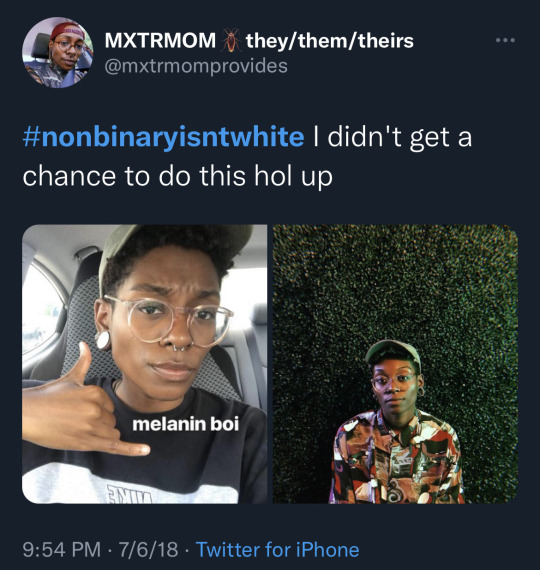

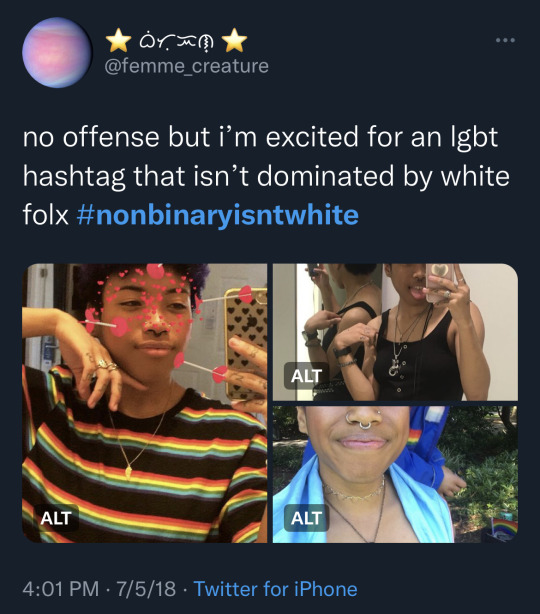
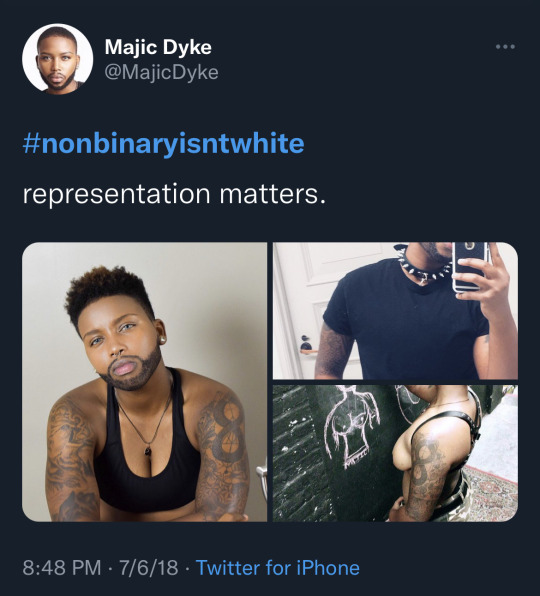

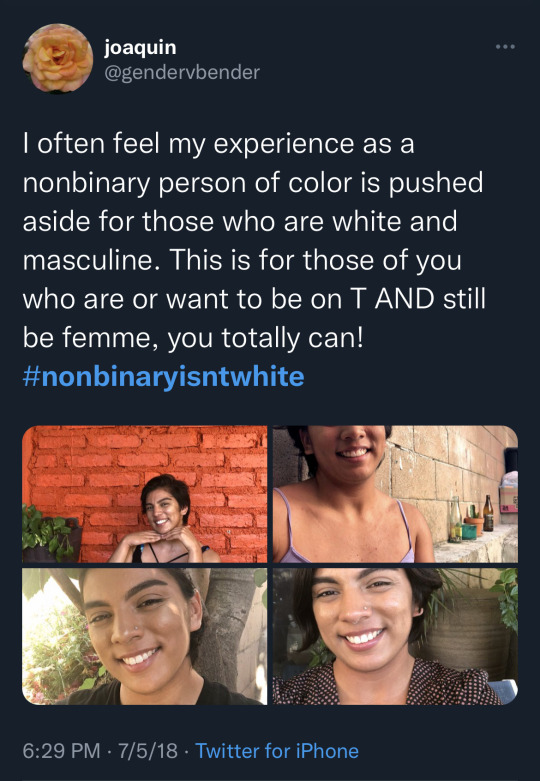

#if you think asexuality or aromanticism or nonbinarity is ‘made up’ or ‘only for white people’ just do some fuckin research#and you’ll find that our communities are a lot more varied and diverse than you give us credit for#racism in lgbt spaces can take on many forms#it isn’t just calling black gays slurs and pushing them out of our communities#it’s also acting like they just don’t even exist#it’s erasure and i’m sick of it#it also sucks to hear from poc because respectability politics will get you nowhere#‘oh that’s a white people problem#WE’RE not like that’#that just throws the qpoc you don’t want to acknowledge under the bus#it does serious harm#racist AND queerphobic#text post#aphobia#racism#enbyphobia#lgbt#lgbtq#whitewashing#transphobia#ace#asexual#aro#aromantic#aroace#nonbinary
2K notes
·
View notes
Text
I keep seeing white book reviewers complain about how Babel is so very in your face and obvious about its rage at colonialism as if they would not twist the meaning of the book to fit into their convenient little worldview and find a way to say 'ok.. BUT' if it were NOT so clearly and explicitly laid out I'm sorry but it's true.
#white people have SUCH a history of taking stories that are clearly by POC talking about their own experiences as POC#and twisting it so that it becomes a problem that they too can relate too. a problem that they also face#blatantly ignoring the intended message simply because it doesn't appeal to their incredibly narrow worldview#like death of the author exists but#there's a difference bw death of the authors and blatant and malicious murder of the author#especially when the work speaks so loudly for itself even distanced from the author#which is why I'm GLAD Babel decided NOT to be subtle or vague#anyway yeah#babel#babel rf kuang#babel or the necessity of violence#babel an arcane history#rf kuang
135 notes
·
View notes
Note
idk i just feel like the more pressing matter with sokka is the fact he’s been played by a white dude than whether or not he still hates women or whatever. and it’s so weird too because the casting for everyone is pretty spot on at least broadly speaking and then you get to sokka and it’s just (karen smith voice) if you’re from the water tribe, why are you white?
Well, for starters, we don't actually know that he is white.
I'm reluctant to relitigate this at this juncture, since there's been a lot of speculation with very little evidence, and frankly, even if he is white, the cast is still a damn sight more diverse than any installment we've ever had. The original main cast of the show was white--with the exception of Zuko and Iroh--as was the main cast of the movie adaptation (again with the exception of Zuko and Iroh, funnily enough), AND the creators were white AND all of the writers were white (and almost all of them were men), which means that there were approximately zero poc with storytelling authority involved with the show. Even if Ian Ousley is white (which is still an if! and I'm not gonna be out here demanding his 23andme results), that's one flub against an entire cast of Asian&indigenous actors, showrunners, writers, and directors (of which there are also considerably more women than the original could boast).
I'm not willing to throw that baby out with the bathwater, so to speak, and I'm going to err on the side of if the rest of the cast is ok with his presence, then it shouldn't bother me too badly. They have excellent chemistry in interviews and on screen, and, from what I've seen, seem to be friends, and that's good enough for me.
Also, I just want to take this moment to point out that trying to rely on looks to determine who is or isn't a poc is problematic at best--and I think that, without bias, Ian doesn't look out of place next to Kia, Dallas, and Gordon. It's not like he's Jackson Rathbone, guys.
#atla#atla la#The Sokka Thing#sokka#ian ousley#even if it is true that he's white it's not necessarily true that he lied to get the role#him believing what he was told growing up about his ancestry does not make him a villain trying to steal roles from actors of color#and i shouldn't have to explain why relying on US validation of a tribe to determine who is and isn't native is. a problem.#but all of that just can't compare to the opportunities that have been given to the other actors&writers&directors who ARE poc#and are getting a chance to tell this story#me: i'm reluctant to relitigate this#also me: AND ONE MORE THING#anyway
47 notes
·
View notes
Text
waaa i need a bf to take care of me when im sick and make me cups of tea and cuddle me forever :( pleaseee
#yeah im sick and im going to make it everyone's problem btw#mlm#nblm#achillean#gay#gay pride#gay yearning#gay mlm#mlm poc#nblm poc#mlm yearning#nblm yearning#trans mlm#t4t mlm
42 notes
·
View notes